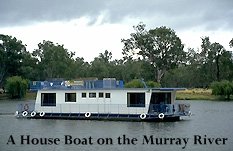 Mildura (2970 kms) A major city and regional centre on the Murray River at the centre of a region known as Sunraysia. This region is also a very profitable fruit growing area providing a high percentage of Australia's dried fruit, a signicant quantity of citrus fruits and a large amount of winemaking grapes. Mildura is also a very popular holiday area.
Mildura (2970 kms) A major city and regional centre on the Murray River at the centre of a region known as Sunraysia. This region is also a very profitable fruit growing area providing a high percentage of Australia's dried fruit, a signicant quantity of citrus fruits and a large amount of winemaking grapes. Mildura is also a very popular holiday area.
Swan Hill (3178 kms) 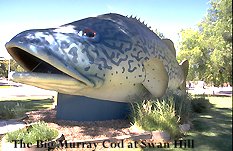 A pleasant city of approximately 10,000 people on the Murray River, at the eastern edge of the Mallee region in north western Victoria. As indicated by the statue of the Giant Murray Cod, this is a popular place for fishing, boating and other water sports. The city is well known for it's Pioneer Settlement, a recreation of a 19th century river port town. We have visited this Pioneer Settlement several times on previous trips and it has numerous attractions for all age groups. On our most recent trip in 1998 we stayed in Swan Hill on our fourth night.
A pleasant city of approximately 10,000 people on the Murray River, at the eastern edge of the Mallee region in north western Victoria. As indicated by the statue of the Giant Murray Cod, this is a popular place for fishing, boating and other water sports. The city is well known for it's Pioneer Settlement, a recreation of a 19th century river port town. We have visited this Pioneer Settlement several times on previous trips and it has numerous attractions for all age groups. On our most recent trip in 1998 we stayed in Swan Hill on our fourth night.
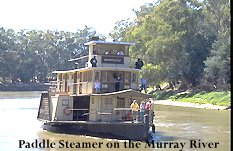 Echuca (3338 kms) Was once the largest inland port in Victoria, and since 1973 paddlesteamers have once again become popular, mainly for receational purposes. Tourism is now the town's main source of income. Echuca was used as the setting for the television series "All The Rivers Run". We stayed here on our fifth night as we re-visited the "World in Wax", a small version of the famous Madame Tussauds Wax Museum.
Echuca (3338 kms) Was once the largest inland port in Victoria, and since 1973 paddlesteamers have once again become popular, mainly for receational purposes. Tourism is now the town's main source of income. Echuca was used as the setting for the television series "All The Rivers Run". We stayed here on our fifth night as we re-visited the "World in Wax", a small version of the famous Madame Tussauds Wax Museum.
Bendigo (3432 kms) Began as one of Victoria's major gold mining towns, with 25 million ounces of gold being produced between 1851 and 1954, when the last gold was extracted from the underground mines. It has grown to become Victoria's fourth largest city, being famous now for its pottery, wineries and eucalyptus farms.
Daylesford (3507 kms) together with neighbouring Hepburn Springs, is famous for its spas and mineral water. Fifty per cent of Australia's known mineral water outlets are located at Daylesford.
Ballarat (3552 kms)  Is another city which grew as a result of the discovery of gold in 1851. Ballarat is famous for the Eureka Rebellion and Stockade in 1854, which was a result of the antagonism towards the Government over miners' license fees. Sovereign Hill Historic Village shows life as it was during the gold rush days and it is possible for visitors to the village to pan for gold at the mine. Ballarat today is Victoria's third largest city. The northern entrance to the city is notable for the Arch of Victory and the Avenue of Honour which is a living memorial to those from the area who have lost their lives in wars.
Is another city which grew as a result of the discovery of gold in 1851. Ballarat is famous for the Eureka Rebellion and Stockade in 1854, which was a result of the antagonism towards the Government over miners' license fees. Sovereign Hill Historic Village shows life as it was during the gold rush days and it is possible for visitors to the village to pan for gold at the mine. Ballarat today is Victoria's third largest city. The northern entrance to the city is notable for the Arch of Victory and the Avenue of Honour which is a living memorial to those from the area who have lost their lives in wars.
Geelong (3640 kms) 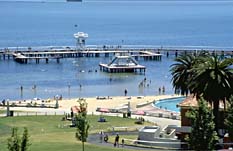 This is our usual destination after our long drive from Perth. Geelong is the place where I grew up. It is Victoria's second city with a population of approximately 200,000 people and is 80km south-west of Melbourne. The city is situated on the shores of Corio Bay and in my opinion is very beautiful, and a great place to live. Being an industrialised centre it received an large influx of post-war European immigrants, including my family. There are many tourist attractions in Geelong, including Eastern Beach which is the largest enclosed swimming area in the world. The people of Geelong are very sport-minded, the city being the home of the AFL team, The Geelong Cats. Check my sports page for further details.
This is our usual destination after our long drive from Perth. Geelong is the place where I grew up. It is Victoria's second city with a population of approximately 200,000 people and is 80km south-west of Melbourne. The city is situated on the shores of Corio Bay and in my opinion is very beautiful, and a great place to live. Being an industrialised centre it received an large influx of post-war European immigrants, including my family. There are many tourist attractions in Geelong, including Eastern Beach which is the largest enclosed swimming area in the world. The people of Geelong are very sport-minded, the city being the home of the AFL team, The Geelong Cats. Check my sports page for further details.
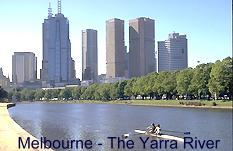 Melbourne This will probably be the destination for most people travelling to Victoria. Melbourne is the capital city of Victoria with a population of approximately 3.2 million people (a bit bigger than Geelong!) There is much to see and do here, and whether you are a fan of shopping, sightseeing, or nightlife, Melbourne has it all.
Melbourne This will probably be the destination for most people travelling to Victoria. Melbourne is the capital city of Victoria with a population of approximately 3.2 million people (a bit bigger than Geelong!) There is much to see and do here, and whether you are a fan of shopping, sightseeing, or nightlife, Melbourne has it all.
Another good link to find out all about Melbourne is The Sydney Morning Herald's Walkabout Travel Guide.